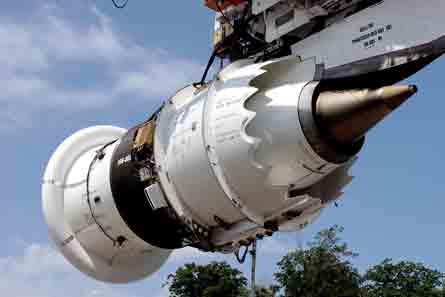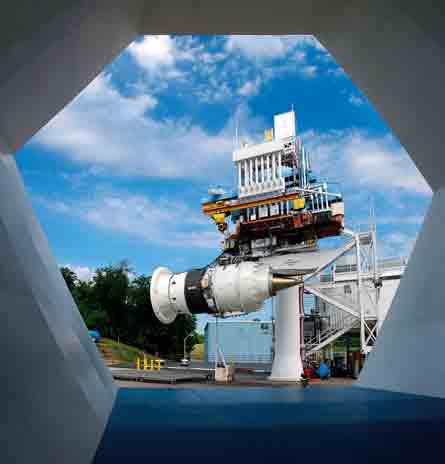Prompted by growing market success, GE is ramping up its GEnx turbofan development and plans test flights in early 2007
General Electric is accelerating its GEnx turbofan development plan for the 787 following its selection in August and September by China Southern, Hainan and Shanghai Airlines. The carriers want to take delivery of their first 787s in June and July 2008 to help meet expected demand for travel to the summer Olympic Games in China that year.
Originally, GE planned to be entering service on the 787 in August 2008 with Japan Airlines as its first customer, “but now we’re bringing the programme forward quite a bit”, says GEnx/CF6 marketing general manager Mel Heard, who adds that, despite the acceleration, “it doesn’t cause any problems from a build or certification point of view”. The latest deal with the Chinese carriers adds a further 54 engines to the growing GEnx sales pot which, including 747-8F and Airbus A350 orders, amounts to some 740 firm engine orders as of mid-September 2006.
|
|---|
The scalloped chevrons are evident on the secondary nozzzle on GE's GEnx test engine |
Certification plan
The test effort is meanwhile “moving extremely smoothly”, says Heard, who adds that all seven ground test engines are on track to be under test by the end of December. All are assigned to the initial Boeing application covering the three currently launched variants, namely the GEnx-54B for the 787-3; the -64B for the 787-8; and the -70B for the 787-9. “We’ve just completed the third engine [003], and so far have more than 580 starts on the first two,” says Heard, who adds that start time (using the new integrated, electrically powered starter specified for the more-electric 787) was as little as 70s with a single starter unit, and 40s with both starters operating. By mid-September, total test hours exceeded some 200h.
Overall the certification plan involves a dedicated core engine, 956-000, plus seven full test powerplants. Engine 000 will be used for high-pressure (HP) turbine stress evaluation as well as HP compressor performance measurement, while the first engine to test, 001, is aimed at assessing performance, crosswind work and vibration. This engine, which made its first run on 19 March at Peebles, Ohio, is also scheduled to be sacrificed in the destructive “blade-out” test in 2007.
Engine 002 is the first to be equipped with production hardware and, as well as having the full nacelle with noise-reducing chevrons, will be fitted with a standard oil cooler, thrust reverser and starter-generator unit. It will be used for emissions and low-pressure (LP) turbine stress work, and the engine will be the first to be measured for key acoustic levels. Engine 002 is also dedicated to endurance running and, with a scheduled completion date in the fourth quarter of 2007, will be one of the longest-serving engines in the certification programme.
Engine 003, which is just now joining the test effort, is set to cover vibration, birdstrike, ice and water ingestion tests. In November, engine 004 will start the 150h “triple redline” US Federal Aviation Administration block test, which sees the engine run for sustained periods in simulated flight cycles up to 6h, at operating limits well beyond normal level. Engine 005 will be the first GEnx to fly on GE’s specially converted 747-100 flying testbed (FTB) by the start of February 2007. The testbed has been modified to take the massive amounts of electrical power that will be generated by the GEnx. Adapted for the more-electric, non-bleed requirements of the 787, the engine will produce more than 1MW compared with around 60kV for current engines of equivalent power.
Maintenance savings
Engine 006 will be used to assess the initial maintenance inspection interval for the GEnx, as well as for a 3,000-cycle ETOPS test. The target is for the GEnx to spend up to 25,000h time on wing between overhauls (TBO), versus 18,000h achieved by the CF6-80C2. Overall, GE is aiming for around a 30% increase in TBO versus the -80C2 – a large slice of the 32% maintenance cost savings at maturity targeted by Boeing for the 787 as a whole.
|
|---|
Engine 002 is set to be one of the hardest working horses of the GEnx test fleet, with testing up to November 2007 |
The ETOPS tests form a critical element of Boeing’s plan to have the 787 certificated for 330min ETOPS at entry-into-service. This represents a virtual doubling of the original 180min ETOPS “out of the box” target for the 777 from just over a decade ago. The seventh engine, which is set to join the series in December, will be used for emissions, icing and ground vibration testing.
The first shipset of “compliance” engines is scheduled to be complete and ready for delivery to Boeing in September 2007, to coincide with the expected award of US Part 33 engine certification. Flight tests on the 787 are then due to begin around October 2007 with two test aircraft involved. European engine certification is due in the first quarter of 2008 and US Part 25 aircraft certification for the GE-powered 787 due around mid-second quarter of 2008.
Selected along with the Rolls-Royce Trent 1000 in April 2004, GE’s fifth-generation turbofan strongly resembles a “mini-GE90”. The 9.5:1-bypass ratio engine features an 111in (2.82m)-diameter high-flow composite fan made up of highly swept composite blades with titanium leading edge cuffs. The GEnx also incorporates counter-rotating HP and LP spools; an advanced 10-stage HP compressor based on the aerodynamics demonstrated on the “Core 7” development version of the GE90-94B; a twin annular pre-mixing swirler (TAPS) combustor; and a low blade-count, seven-stage LP turbine. The LP compressor has four stages, while the HP turbine has the traditional GE big engine two-stage layout.
Improved combustion
For reduced weight and noise GE designed the GEnx with just 18 fan blades, compared with 22 on the GE90 and 36 in the CF6 family. The case itself is made of a composite-fibre braid, which involves laying down three triaxial braids in a weave mixed with biaxial braids. A slightly thicker weave is laid down for the centre section to obviate the need for the traditional Kevlar containment case used in conventional engines.
The blades, like those of the GE90, are made in San Marco, Texas by CFAN, a joint GE/Snecma concern that is now gearing up to handle the upcoming production loads of not only the bigger engine, but also the GEnx for the 787, 747-8 (for which the engine was selected as sole source in 2005) and the Airbus A350. The composite fan case, introduced as a way of saving around 350lb (160kg) per engine, is being produced by GKN Aerospace at its Alabama Aerostructures site in Tallassee.
The TAPS combustor, which pre-mixes the air and fuel before they are burned, allows the combustion process to be more complete at lower temperatures and is expected to produce a 30% improvement in emissions over the CF6. The combustor incorporates a pair of annular fuel/air “swirls” that pre-mix the two before funnelling the mixture to the relatively conventional combustor. The inner swirler is used for low-thrust requirements in idle and taxiing, while the outer swirler engages for higher thrust settings. ■
Source: Flight International

























